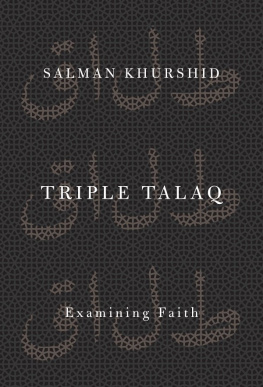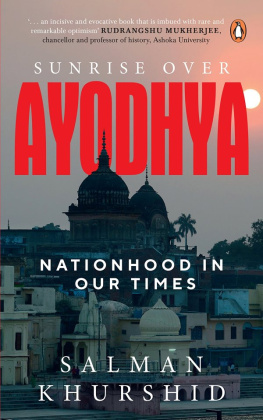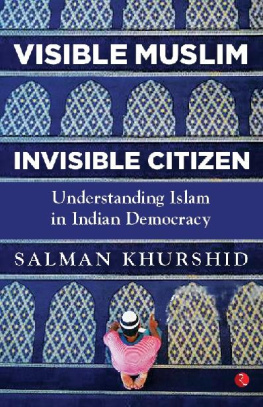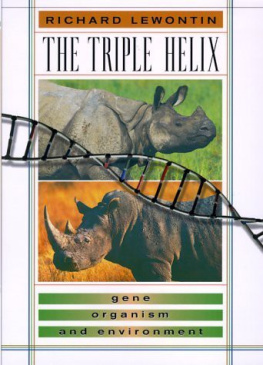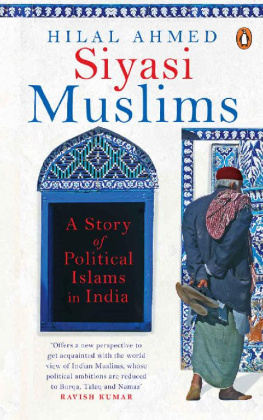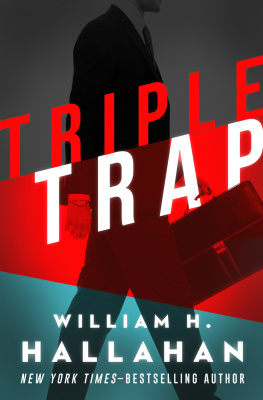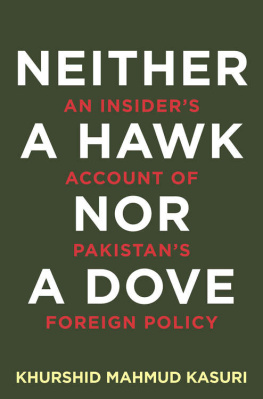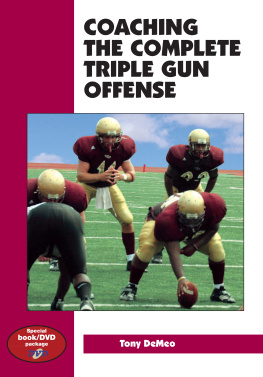Khurshid - Triple talaq: examining faith
Here you can read online Khurshid - Triple talaq: examining faith full text of the book (entire story) in english for free. Download pdf and epub, get meaning, cover and reviews about this ebook. City: Oxford, year: 2018;2018, publisher: Oxford University Press, genre: Religion. Description of the work, (preface) as well as reviews are available. Best literature library LitArk.com created for fans of good reading and offers a wide selection of genres:
Romance novel
Science fiction
Adventure
Detective
Science
History
Home and family
Prose
Art
Politics
Computer
Non-fiction
Religion
Business
Children
Humor
Choose a favorite category and find really read worthwhile books. Enjoy immersion in the world of imagination, feel the emotions of the characters or learn something new for yourself, make an fascinating discovery.
Triple talaq: examining faith: summary, description and annotation
We offer to read an annotation, description, summary or preface (depends on what the author of the book "Triple talaq: examining faith" wrote himself). If you haven't found the necessary information about the book — write in the comments, we will try to find it.
Triple talaq: examining faith — read online for free the complete book (whole text) full work
Below is the text of the book, divided by pages. System saving the place of the last page read, allows you to conveniently read the book "Triple talaq: examining faith" online for free, without having to search again every time where you left off. Put a bookmark, and you can go to the page where you finished reading at any time.
Font size:
Interval:
Bookmark:
Triple Talaq
Triple Talaq
Examining Faith
salman khurshid


Oxford University Press is a department of the University of Oxford.
It furthers the Universitys objective of excellence in research, scholarship,
and education by publishing worldwide. Oxford is a registered trademark of
Oxford University Press in the UK and in certain other countries.
Published in India by
Oxford University Press
2/11 Ground Floor, Ansari Road, Daryaganj, New Delhi 110 002, India
Oxford University Press 2018
The moral rights of the author have been asserted.
First Edition published in 2018
All rights reserved. No part of this publication may be reproduced, stored in
a retrieval system, or transmitted, in any form or by any means, without the
prior permission in writing of Oxford University Press, or as expressly permitted
by law, by licence, or under terms agreed with the appropriate reprographics
rights organization. Enquiries concerning reproduction outside the scope of the
above should be sent to the Rights Department, Oxford University Press, at the
address above.
You must not circulate this work in any other form
and you must impose this same condition on any acquirer.
ISBN-13 (print edition): 978-0-19-948740-0
ISBN-10 (print edition): 0-19-948740-5
ISBN-13 (eBook): 978-0-19-909325-0
ISBN-10 (eBook): 0-19-909325-3
Typeset in Trump Mediaeval LT Std 9.5/14.5
by Tranistics Data Technologies, Kolkata 700 091
Printed in India by Replika Press Pvt. Ltd
Contents


The genre of this book is an unusual one. People often write about great social and political events they have been a part of, or indeed, watched from a position of proximate advantagewhat is described as the ringside view. I have known of many such short recollections of authors regarding landmark cases, such as the late senior advocate T. Andhyarujinas account of
The flavour of public discourse in recent years, undoubtedly influenced by political ideologies whose fortunes have been on the rise, is beginning to get a bit sharp. Populism has greatly overshadowed the idealism of the spirit of Independence (hopefully only as a transitory phase). It is a moral imperative for people who believe in the idea of India to resist irreparable damage to the heritage we cherish and without which, no matter what the beliefs to the contrary, we will never be what we are and must remain. The building blocks of such an endeavour are numerous and the parts of the whole will indeed take enormous effort to put together. Yet each part is invaluable in itself and I hope that this sagathat of the Triple Talaq case before the Supreme Courtis and will continue to be one such part.
Interestingly, a constitutional case lasts only for a few hearings and is followed by written submissions, if they have not already been presented before the Bench when the oral arguments commence. But despite the time and the often combative exchange between counsels for parties, what happens in court is but a small part of what goes on in the world outside; indeed, even of what happens in court, only a small part is actually reported by the media and reproduced in the judgment. Understandably, there are constraints of space, time, context, and understanding; so, reproducing a virtual blow-by-blow account of court proceedings with a contextual gloss might be of help to larger audiences. It is with that in mind that I have attempted to write this book.
Religion has an interesting relationship with modern democracies: in Mexico, public display of religious symbols or even clothes is prohibited;
Judges often have to decide what religion means for legal purposes. For example, the US Supreme Court had to decide whether, when Congress provided a conscientious objection exemption from military service for men whose religion would not allow them to serve, this would also extend to an atheist whose moral convictions prohibited it. It decided
The ECtHR quite succinctly captures the context of its wide interpretation of religious freedom in the following paragraph:
As enshrined in Article 9 (art. 9), freedom of thought, conscience and religion is one of the foundations of a democratic society within the meaning of the Convention. It is, in its religious dimension,
Hence, the phrase religious atheism, however surprising, is not an oxymoron; religion
The Triple Talaq case offered the opportunity to consider the very idea of religion, but the Court thought it appropriate not to dive into a metaphysical or philosophical exercise, limiting its attention to what might be described as the laymans religion. Yet, somehow it seems that drawing distinctions between the core or essential part of religion and the peripheral aspect cannot be attempted without an understanding of the nature of religion.
Our Constitution is the original compact between citizens through their representatives in the Constituent Assembly that provides for rights granted to the State (the collective rights of society) as indeed rights of the citizen against the State. Somewhat later the idea of Fundamental Duties took shape, but conceptually that is an explicit expression of the rights of the State. Among the rights of the citizen identified are the rights to equality, liberty, conscience, trade, organization, speech, and the right to practise and profess religion. Interestingly, over the decades most of these rights have been amplified and expanded far beyond the pale of the language used in the Constitution, such as the recognition of substantive Due Process. However, with respect to religion, the Court has been somewhat tight-fisted and treated it as a dimension of our national life that has to be tolerated rather than celebrated.
The best that the Court could do was to fall back on the convenient distinction between the essential or core part of religion and its peripheral dimension. In 1954, the Supreme Court said:
What constitutes the essential part of a
This, of course, is where Justice K. Ramaswamy stated:
In pluralistic society like India there are numerous religious groups who practise diverse forms of worship or practise religions, rituals, rites etc.; even among Hindus, different denominants and sects residing within the country or abroad profess different religious faiths, beliefs, practices. They seek to identify religion with what may in substance be mere facets of religion. It would, therefore, be difficult to devise a definition of religion which would be regarded as applicable to all religions or matters of religious practices. To one class of persons a mere dogma or precept or a doctrine may be predominant in the matter of religion; to others, rituals or ceremonies may be predominant facets of religion; and to yet another class of persons a code of conduct or a mode of life may constitute religion. Even to different persons professing the same religious faith some of the facets of religion may have varying significance. It may not be possible, therefore, to devise a precise definition of universal application as to what is religion and what are matters of religious belief or religious practice.
He added that this did not mean, however, that it was
[n]ot possible to state with reasonable certainty the limits within which the Constitution conferred a right to profess religion. Therefore, the right to religion guaranteed under Article 25 or 26 is not an absolute or unfettered right to propagating religion which is subject to legislation by the State limiting
Next pageFont size:
Interval:
Bookmark:
Similar books «Triple talaq: examining faith»
Look at similar books to Triple talaq: examining faith. We have selected literature similar in name and meaning in the hope of providing readers with more options to find new, interesting, not yet read works.
Discussion, reviews of the book Triple talaq: examining faith and just readers' own opinions. Leave your comments, write what you think about the work, its meaning or the main characters. Specify what exactly you liked and what you didn't like, and why you think so.

